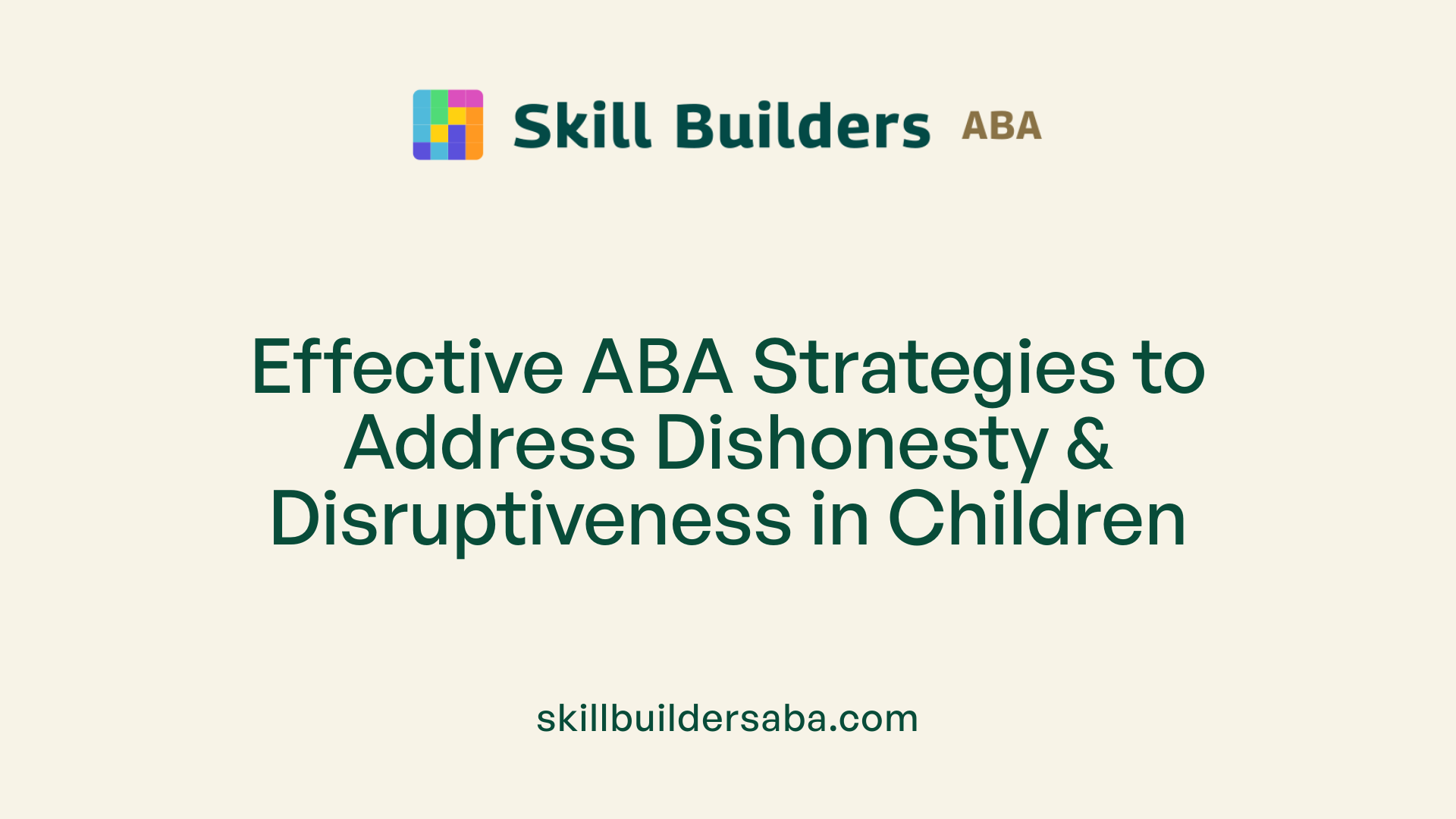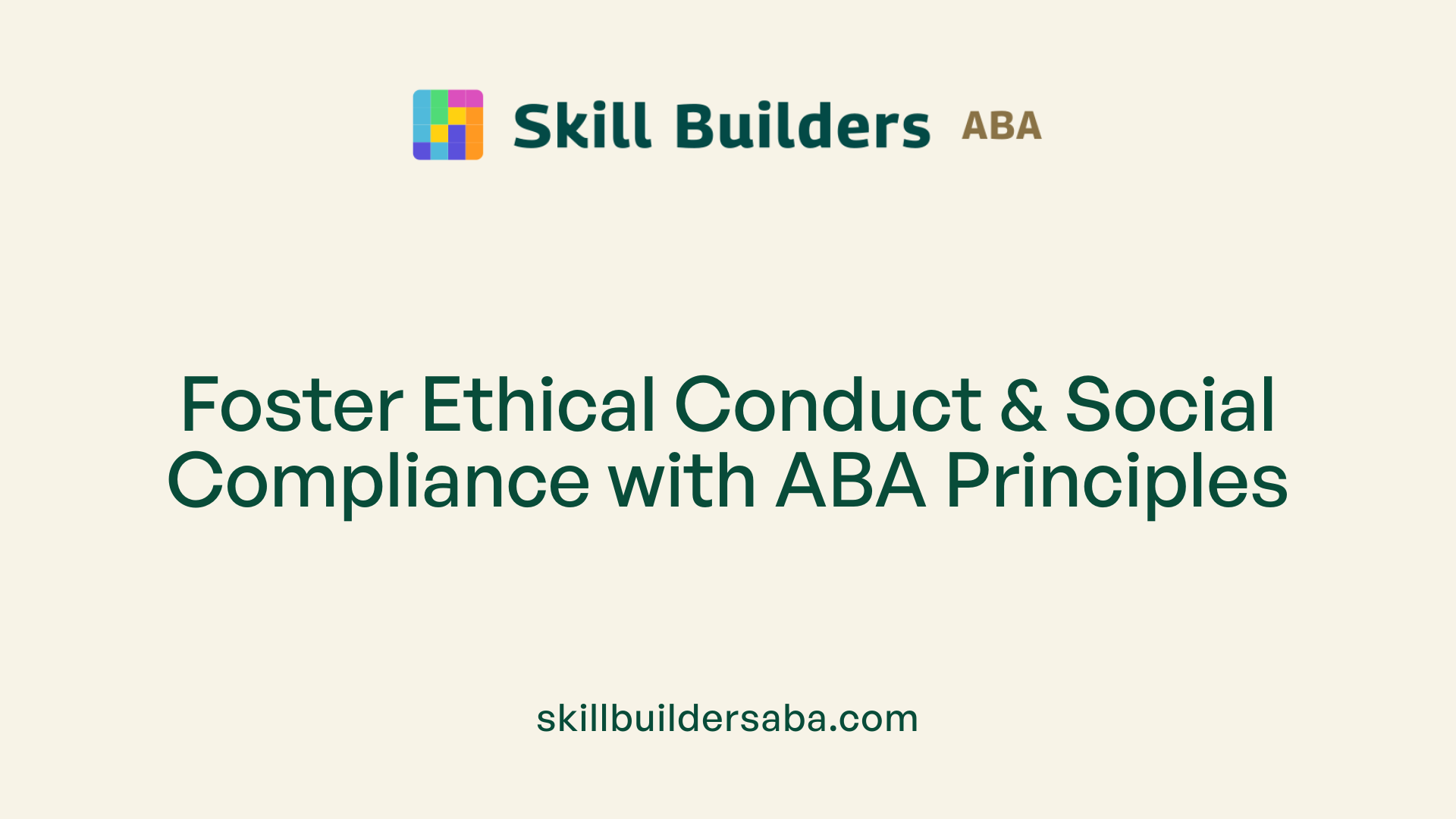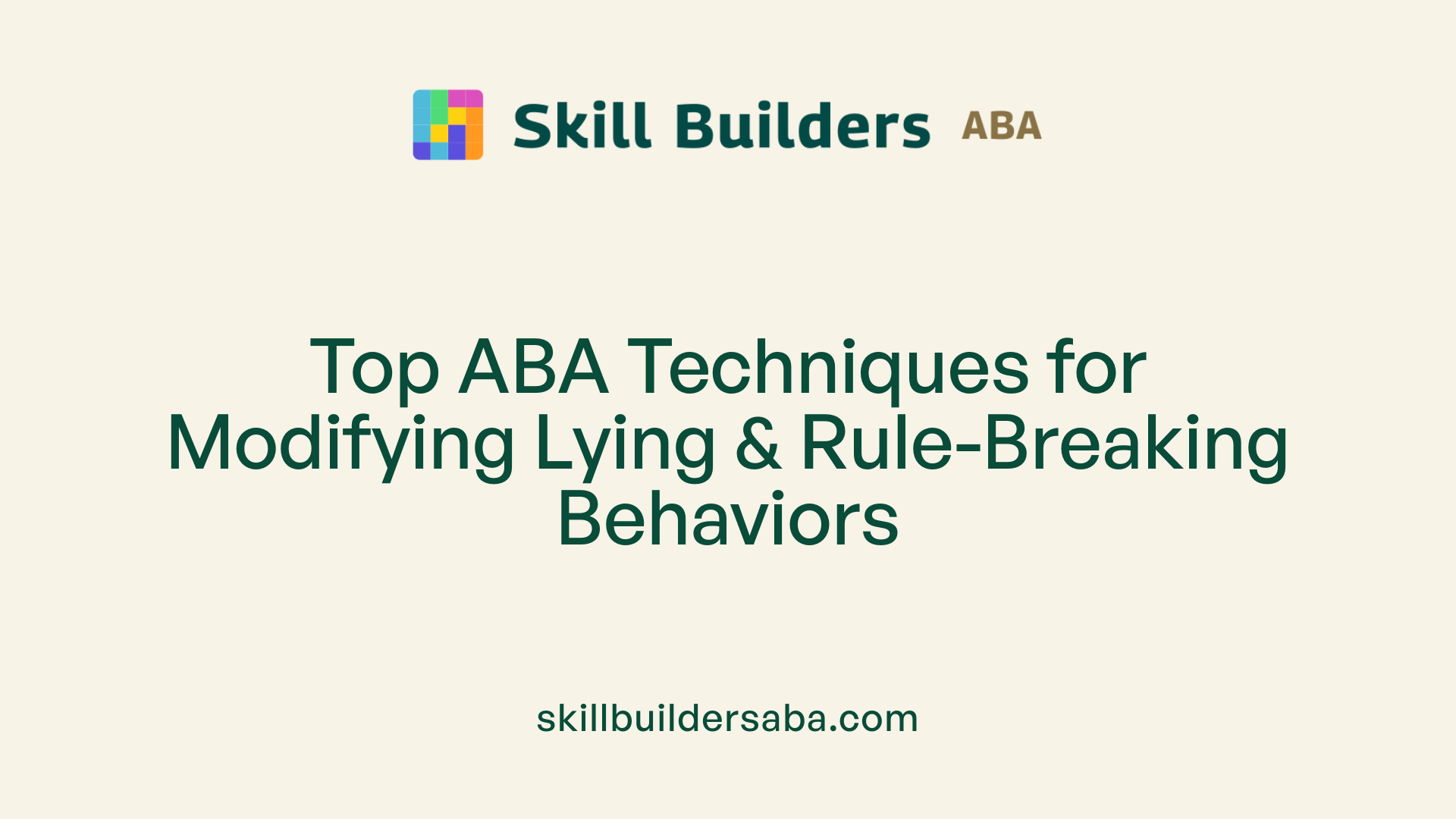
Can ABA help address lying and rule-breaking
Exploring Behavioral Interventions for Honesty and Rule Compliance
Understanding ABA’s Role in Shaping Ethical Behavior in Children
Applied Behavior Analysis (ABA) is a widely recognized approach used to modify various children's behaviors, including challenging issues like dishonesty and rule-breaking. Recent research highlights that ABA techniques are effective not only in managing disruptive behaviors but also in fostering honesty, ethical conduct, and social compliance. This article delves into how ABA strategies are applied to promote truthful and rule-abiding behavior, emphasizing scientific evidence, practical interventions, and ethical considerations.
ABA Strategies for Managing Behavioral Issues such as Dishonesty and Disruptiveness

What are some ABA strategies for managing behavioral issues such as dishonesty and disruptive behaviors?
Applied Behavior Analysis (ABA) offers a structured and effective approach to addressing behaviors like lying and disruptive conduct in children. At its core, ABA relies on a variety of techniques aimed at encouraging positive behaviors and reducing problematic ones.
One fundamental strategy is positive reinforcement. When children demonstrate honesty or appropriate social behaviors, adults provide rewards such as praise, tokens, or privileges. This encourages the child to repeat these desirable behaviors. The study by Lehardy et al. (2022) underscores the effectiveness of reinforcement in shifting behavior patterns, particularly in children with Autism Spectrum Disorder.
Beyond reinforcement, antecedent interventions play a pivotal role. These involve modifying the environment or providing visual supports to clarify expectations before behaviors occur. For example, visual schedules can help children understand what is expected of them, thereby decreasing opportunities for rule-breaking or dishonesty.
Environmental modifications also include adjusting physical surroundings to reduce triggers for disruptive or dishonest behaviors. This might involve organizing the space to minimize distractions or creating designated quiet areas to help children regulate their emotions.
Prompting and fading are additional techniques that facilitate the learning of new, appropriate behaviors. Prompts—such as visual cues or gestures—are initially provided to guide the child. Over time, these prompts are gradually faded to promote independence in the desired behavior.
Behavior management strategies include redirection, where a child is guided toward a more acceptable activity when engaging in problematic behavior. Time-outs can be employed as a consequence for rule-breaking, providing the child an opportunity to regain composure. Differential reinforcement involves reinforcing a behavior that is more acceptable and ignoring or not reinforcing undesirable behaviors.
Crucial to personalized intervention is the use of Functional Behavior Assessments (FBAs). An FBA helps identify the underlying causes or triggers for specific behaviors. Based on this assessment, a tailored Behavior Intervention Plan (BIP) is developed, which outlines specific strategies to address the root causes of dishonesty or disruptiveness.
Implementing these techniques consistently in both clinical and home settings can significantly reduce problematic behaviors and promote social and communication skills, especially in children with communication deficits linked to their behavior.
| Strategy | Description | Typical Use Cases | Benefits |
|---|---|---|---|
| Positive reinforcement | Rewards for desired behaviors | Honesty, social skills, rule-following | Increases occurrence of beneficial behaviors |
| Visual supports & environmental modifications | Structure and clarify expectations through visuals or environment tweaks | Reducing rule-breaking, promoting independence | Prevents problem behaviors before they occur |
| Prompting & fading | Guided cues that fade over time to foster independence | Teaching new skills, reducing reliance on prompts | Supports skill acquisition and generalization |
| Redirection & time-outs | Redirects attention to positive activities or short time-outs for rule-breaking | Managing disruptions in daily routines | Immediate behavior control and learning opportunities |
| Functional Behavior Assessments & Behavior Intervention Plans | Identifies causes and develops tailored strategies | Consistent problematic behaviors | Effective, personalized behavior management |
Understanding these strategies can empower caregivers, educators, and therapists to effectively address dishonesty and disruptive behaviors in children, leading to healthier social interactions and improved developmental outcomes.
How ABA Techniques Can Reduce Lying and Encourage Honesty in Children

How does ABA help reduce lying and rule-breaking behaviors in children?
Applied Behavior Analysis (ABA) employs a structured approach to shape and reinforce desirable behaviors, including honesty. This method involves systematically identifying instances of dishonesty or rule-breaking, and then applying reinforcement techniques when children report truthfully or adhere to rules. When children are rewarded for honesty, the likelihood that they will repeat these behaviors increases, effectively reducing lying and misbehavior.
The interventions typically start with establishing a solid understanding of baseline behaviors, which include specific dishonest acts such as lying or rule violations. Once these behaviors are identified, targeted strategies are implemented.
What are systematic reinforcement methods?
Reinforcement methods are fundamental in ABA and include positive reinforcement—giving children praise, tokens, or other rewards when they behave honestly or follow rules. This encourages ongoing truthful behavior. Conversely, undesirable behaviors like lying are less likely to recur if they are not reinforced or are appropriately corrected.
ABA strategies also incorporate structured routines and visual supports that help children understand expected behaviors. These supports can serve to remind children of the benefits of honesty and the natural consequences of rule-breaking.
How are behaviors of dishonesty identified?
Behavioral observations and data collection are core components of ABA. Therapists or parents monitor children’s actions and specifically note instances of dishonesty or rule violations. Recognizing patterns allows for targeted intervention, and recording progress helps evaluate the effectiveness of the strategies.
What environmental conditions promote honesty?
Certain environmental conditions can foster more honest behaviors. These include creating a safe and non-judgmental setting where children feel comfortable reporting mistakes, reinforcing effort to tell the truth, and establishing clear, consistent rules. Implementing these conditions Iargely depends on reinforcement and structured interactions.
What does structured protocol involve?
The typical ABA protocol includes several phases:
- Prompting: reminding children of expectations and desired behaviors.
- Correction: guiding children towards truthful behavior without punishment.
- Natural Environment Teaching (NET): incorporating honesty and rule adherence naturally into everyday settings.
Researchers like Lehardy et al. (2022) have demonstrated that such protocols effectively increase honesty and decrease rule-breaking, especially when reinforced in naturalistic settings.
What research supports ABA’s effectiveness?
The study by Lehardy et al. (2022) provides strong evidence that ABA-based interventions can significantly reduce transgressions among children, including those with Autism Spectrum Disorder. The research highlights that reinforcing honesty and applying consistent behavioral techniques not only improve ethical conduct but also enhance social and communication skills.
In practical terms, these findings suggest that ABA can be a powerful tool for parents, educators, and therapists aiming to promote honesty and decrease rule-breaking in various child populations.
Additional support through parent and family involvement
Parent behavior therapy and group parent training further supplement ABA interventions. These programs empower caregivers to apply reinforcement strategies effectively at home, ensuring consistency in behavioral support.
In summary, ABA techniques—emphasizing reinforcement, structured routines, direct teaching, and environmental modifications—offer an evidence-backed approach to reducing lying and promoting honesty. By fostering environments that reward truthful behaviors and clearly define acceptable conduct, children can develop stronger ethical habits that contribute positively to their social relationships and personal growth.
Application of ABA Principles to Foster Ethical Conduct and Social Compliance

How are ABA principles applied to promote ethical and compliant behavior in children?
Applied Behavior Analysis (ABA) employs sound, scientifically supported strategies to encourage ethical and socially acceptable behaviors in children. Central to this approach is the use of evidence-based interventions that are crafted with the child's welfare as a priority. For instance, programs focus on reinforcing positive behaviors like honesty and rule-following, which are critical for healthy social interactions.
In practical terms, behavior analysts utilize reinforcement strategies whereby desirable behaviors such as reporting truthfully are rewarded. Conversely, undesirable behaviors like rule-breaking are addressed through carefully designed consequence systems to reduce their frequency. These methods are implemented following a structured process—starting from establishing a clear baseline and then progressing through phases that increase positive behaviors and decrease problematic ones.
Beyond behavior modification, ABA professionals adhere to core ethical principles like beneficence, which emphasizes actions that benefit the child; non-maleficence, ensuring no harm comes from interventions; and justice, providing fair and equitable treatment. This is achieved by routinely reviewing intervention effectiveness through scientific research and adjusting strategies as needed.
Maintaining professional competence is another vital aspect. Behavior analysts engage in ongoing training, supervision, and peer review aligned with the Behavior Analyst Certification Board (BACB) Ethics Code. These standards underscore the importance of honesty, integrity, and cultural sensitivity, ensuring interventions are respectful and appropriate for each child's unique background.
Informed consent and confidentiality are fundamental protections in ABA practice. Parents or guardians are fully informed about intervention goals, methods, and potential risks, enabling them to make voluntary decisions about their child’s treatment. Confidential information is securely stored and only shared within the bounds of ethical practice.
Cultural responsiveness and professional competence are integrated into ABA by continuously learning about diverse backgrounds and tailoring interventions to fit the child's cultural context. This respect enhances engagement and effectiveness.
Finally, ABA’s commitment to promoting dignity, autonomy, and justice manifests in empowering children with skills that foster independence and social participation. For example, teaching honesty not only reduces rule violations but also supports the development of trust and respect within relationships.
In summary, ABA principles are applied ethically in children’s behavioral interventions by focusing on evidence-based practices that promote welfare, respect individual rights, and uphold societal values. This holistic approach ensures that behavior management is both scientifically valid and morally sound, facilitating positive developmental outcomes and social compliance.
Common ABA Techniques for Modifying Lying and Rule-Breaking Behaviors

What are some common ABA techniques used to modify behaviors like lying and rule-breaking?
Applied Behavior Analysis (ABA) offers a variety of effective strategies for addressing behaviors such as lying and rule-breaking in children, including those on the autism spectrum. These techniques focus on changing behavior through structured, evidence-based methods that reinforce positive actions and diminish problematic ones.
One of the foundational approaches is positive reinforcement. This method rewards children when they demonstrate honesty or follow rules, encouraging them to repeat these behaviors. By providing praise, tokens, or other motivators, children learn the value of honesty and compliance.
Prompting and fading are also widely used. Initially, prompts—such as verbal cues, gestures, or visual aids—help guide children towards appropriate behaviors. Over time, these prompts are gradually reduced or faded out, allowing children to perform behaviors independently.
Behavior chaining is another useful technique, especially for complex tasks involved in honesty or rule adherence. This involves breaking down behaviors into smaller, manageable steps. Teaching each step sequentially builds a complete, functional behavior.
Differential reinforcement strategies—namely DRA (Differential Reinforcement of Alternative behaviors), DRI (Differential Reinforcement of Incompatible behaviors), and DRO (Differential Reinforcement of Other behaviors)—are tailored to reinforce behaviors that substitute or prevent lying and rule-breaking. For instance, DRA might reinforce a child’s honest report instead of deception, while DRO could reinforce the absence of lying over a specified period.
Visual modeling and script fading are effective for teaching socially appropriate responses. Children observe models demonstrating honest and rule-abiding behaviors, then gradually fade the support as they become more competent.
Behavior contracts and token economies introduce explicit agreements and tangible incentives. A contract specifies expected behaviors and consequences, while tokens can be exchanged for preferred activities or items, motivating compliance and honesty.
Understanding the function behind problematic behaviors like lying is crucial. Function-based interventions assess why a child engages in dishonest or rule-breaking actions—whether for escape, attention, or sensory reasons—and develop strategies to address these underlying needs.
Incorporating these ABA techniques creates a comprehensive approach to reduce dishonesty and rule-breaking, fostering better social interactions and communication skills. The interventions are adaptable for home and clinical settings and are most effective when consistently applied by trained professionals and informed parents.
Supporting Ethical Behavior through Evidence-Based Strategies
In conclusion, ABA offers a comprehensive framework for addressing lying and rule-breaking behaviors in children. Through scientifically validated techniques such as reinforcement, antecedent modifications, prompting, and functional assessments, ABA can effectively foster honesty, ethical conduct, and social compliance. Moreover, adherence to ethical principles ensures that interventions respect children’s rights, promoting not only behavioral change but also dignity and autonomy. As research, like the study by Lehardy et al. (2022), demonstrates, early and consistent application of ABA strategies can create lasting positive outcomes, supporting children in developing trustworthy and socially responsible behavior. When combined with family participation and professional oversight, ABA remains a powerful tool for nurturing ethical and compliant behaviors in children.
References
- Don't Lie to Me! - ABLE | ABA Autism Therapy
- ABA Research Blog | ABLE
- Rule Breaking, Defiance, & Acting Out - Effective Child Therapy
- ABA Therapy Activities To Do At Home - Autism Parenting Magazine
- Rule 4.1 Truthfulness In Statements To Others - Comment
- Don't Lie to Me! - ABLE | ABA Autism Therapy
- Rule Breaking, Defiance, & Acting Out - Effective Child Therapy
- ABA Therapy for ADHD: Strategies to Improve Focus & Behavior
- Behavioral Interventions for Anger, Irritability, and Aggression in ...
Reach Out Today
Learn more about how we can support your child’s growth and development. Contact us to discuss our services and availability in your area.
.svg)